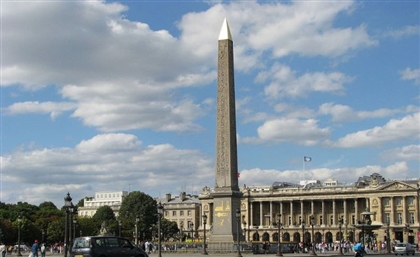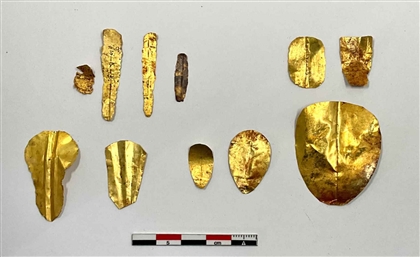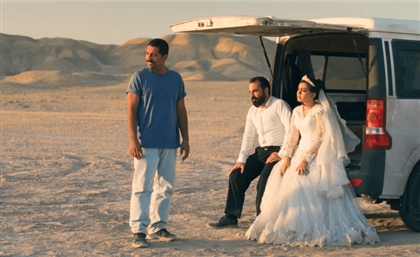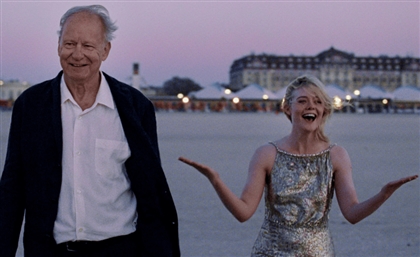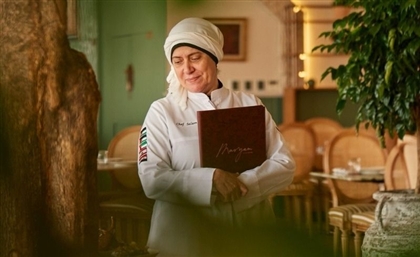When Europe Ate Mummies: How Colonial Cannibalism Lasted Centuries
Once destined for the afterlife, these ancient dead had become commercial goods, shipped to Europe where they were crushed into pigment, powdered for medicine, unwrapped at parties, or even consumed.
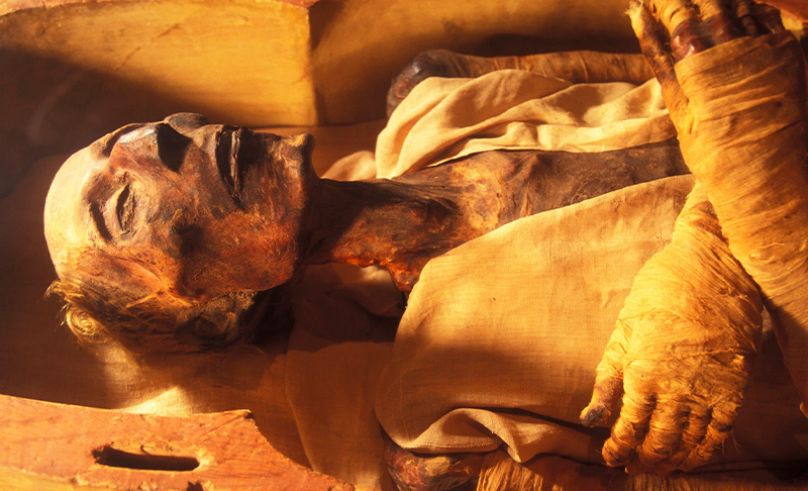
In the grainy photograph, the man sits cross-legged beside two stiff, linen-wrapped corpses. The vendor does not smile. His posture suggests this is ordinary business. In a sense, it was.
That year, in 1865, Western travellers to Egypt could buy a mummified body. Once destined for the afterlife, these ancient dead had become commercial goods, shipped by the crate-load to Europe where they were crushed into pigment, powdered for medicine, unwrapped at parties, or, most disturbingly, consumed.
The practice, colloquially referred to as ‘mummy medicine’, was more than a passing fad. For centuries, Europeans ingested the remnants of ancient Egyptians with the belief that doing so might heal them. The logic, though warped by distance and desire, was not incidental. It was built on a collision of scientific misunderstanding, colonial hunger, and philosophical confusion about what the dead owe the living.
-ea49ecbe-5b37-4754-8337-cc25c22a9b95.jpg) The belief in mumia's healing power was deeply rooted in prevailing medical theories of the time. One such theory was the doctrine of signatures, which held that natural substances resembled the ailments they were meant to cure. Mummified flesh, preserved for centuries, seemed an obvious candidate for treating decay, wounds, and internal deterioration.
The belief in mumia's healing power was deeply rooted in prevailing medical theories of the time. One such theory was the doctrine of signatures, which held that natural substances resembled the ailments they were meant to cure. Mummified flesh, preserved for centuries, seemed an obvious candidate for treating decay, wounds, and internal deterioration.
The origins of this strange commerce trace back to a linguistic and pharmacological confusion. In the Arabic language, the word ‘mumia’ referred to bitumen, a sticky, tar-like substance used by ancient Egyptians in the embalming process. Bitumen itself was thought to possess curative properties, especially for internal bleeding or bruising. By the 12th century, European apothecaries had begun importing it under the same name.
But over time, the material truth behind mumia shifted. As medieval physicians and pharmacists grew more eager for the miraculous powers of “mummy,” they began harvesting it not from mineral deposits, but from the mummified bodies themselves. Whether by misunderstanding or willful redefinition, the corpse had replaced the compound itself.
By the 16th century, mummy powder, scraped from desiccated flesh and ground into a fine brown dust, was a fixture in European pharmacies. “Take the bones of an unspoiled mummy,” advised French physician Guy de la Fontaine, “reduce them to powder and mix them with a bit of wine.” This was mainstream medicine for them.
-1f330670-4344-4edf-96f2-85f73a6282a6.jpg) A 1672 edition of the London Pharmacopoeia recommended mumia vera aegyptiaca, ‘true Egyptian mummy’, as a treatment for epilepsy, bruising, and internal hemorrhage. The French king Francis I is said to have carried mummy powder in a pouch around his neck. The British aristocracy swallowed it by the spoonful. Sanctified cannibalism was justified scientifically.
A 1672 edition of the London Pharmacopoeia recommended mumia vera aegyptiaca, ‘true Egyptian mummy’, as a treatment for epilepsy, bruising, and internal hemorrhage. The French king Francis I is said to have carried mummy powder in a pouch around his neck. The British aristocracy swallowed it by the spoonful. Sanctified cannibalism was justified scientifically.
To understand how such a practice could be so widely accepted, one must examine the medical logic of the time. Renaissance and early modern medicine was dominated by the humoral theory, in which health depended on the balance of four bodily fluids: blood, phlegm, black bile, and yellow bile. Illness indicated imbalance. Remedies were needed to counteract it.
Mummified flesh, being dry and dark, was seen as ideal for absorbing excess humors. Moreover, the fact that these remains had withstood centuries in desert tombs seemed to signify resilience.
“There was also the allure of the exotic. Egypt, ancient, mysterious, and distant, offered an imaginative cure for European anxieties about death and decay,” Monica Hanna - Egyptian Egyptologist, scholar and Dean at the Arab Academy for Science, Technology & Maritime Transport - tells CairoScene. “To ingest a mummy was, in effect, to ingest the magic of immortality.”
-f7f2c4fc-868c-4d3a-b738-89d9b0df87b7.jpg) But this logic carried a darker implication: to consume another human, stripped of name and identity, was acceptable so long as that human came from elsewhere, both geographically and historically. “What mattered was not the life that had been lived, but the myth that could now be bottled and sold,” Hanna reflects.
But this logic carried a darker implication: to consume another human, stripped of name and identity, was acceptable so long as that human came from elsewhere, both geographically and historically. “What mattered was not the life that had been lived, but the myth that could now be bottled and sold,” Hanna reflects.
The dead served not only the sick, but the vain and the curious. By the 18th century, mummies had become fashionable in European drawing rooms.
Mummy unwrapping parties, popular among Victorian elites, turned human remains into parlour spectacle. Attendees, often wealthy patrons or amateur scholars, would gather to watch an “orientalist” expert, usually a male collector or physician, slowly peel away the layers of an ancient body. Gasps would follow the unveiling of teeth, nails, amulets. Sometimes a long-preserved hand would be passed around the room.
-ebd7a1bd-b27b-481f-942e-b25530a9d249.jpg) These events were framed as scientific, even reverent. But their true function was voyeuristic. To unwrap a mummy was to metaphorically dominate the past, to possess not just the body, but the narrative of history.
These events were framed as scientific, even reverent. But their true function was voyeuristic. To unwrap a mummy was to metaphorically dominate the past, to possess not just the body, but the narrative of history.
The echoes of these events are still seen today. “The mummified body of Shepenese, an ancient Egyptian priestess, lies half-naked in a glass coffin in Switzerland’s Abbey Library of St. Gallen — her chest unwrapped. Looted from her tomb in the early 19th century, Shepenese has been exhibited for decades as a tourist attraction. Now, over 200 Egyptian scholars, archaeologists, and civil society figures — joined by Swiss academics and cultural leaders — are demanding her repatriation.” Hanna tells Cairoscene.
Meanwhile, artists were finding another use for the ancient dead. A pigment known as ‘mummy brown’ was made by boiling ground mummy powder with white pitch and myrrh, resulting in a rich, smoky hue ideal for glazing. The Pre-Raphaelite Brotherhood and other Romantic painters prized it for its depth.
The irony was cruel: in being dismembered and repurposed, the mummies were being “preserved” again, this time not in linen, but in oil on canvas.
-cf1b1d11-20a3-4059-80ed-89267d2668c2.jpg) By the mid-19th century, demand had grown so great that supply faltered. Egyptian tombs, already ransacked, were running dry. Enterprising merchants responded with counterfeit mummies, sometimes made from the bodies of contemporary Egyptians, beggars, or criminals, treated with tar and buried briefly in sand to mimic ancient desiccation.
By the mid-19th century, demand had grown so great that supply faltered. Egyptian tombs, already ransacked, were running dry. Enterprising merchants responded with counterfeit mummies, sometimes made from the bodies of contemporary Egyptians, beggars, or criminals, treated with tar and buried briefly in sand to mimic ancient desiccation.
The product is mystique.
Though much of this trade occurred with the complicity of European and Egyptian middlemen alike, it was built on a profound erasure. The people whose bodies were sold, pharaohs and farmers, mothers and children, were never named. Their wishes, if recorded, were discarded. Their tombs, often sealed with prayers for peace, were breached in the name of curiosity and commerce.
European museums and collectors often justified the trade as a civilizing mission: to rescue antiquity from ignorance. Yet as National Geographic notes, this collecting was often indistinguishable from plunder. During Napoleon’s Egyptian campaign in 1798, thousands of artifacts were removed from temples and tombs. By the late 1800s, mummy exports from Egypt had become so routine that customs authorities listed them as bulk goods, alongside cotton and dates.
In one reported case, hundreds of mummies were ground up for fertilizer.
“Medical cannibalism, though framed as a rational practice, rested on a deeply irrational foundation: that the dead could be consumed without consequence if they were far enough removed from one’s own sense of self. Ingesting a corpse was unthinkable—unless that corpse was foreign, ancient, and exoticised,” Hanna tells CairoScene.
In this, mummy consumption reveals something enduring about the Western philosophical relation to the ‘Other’. As philosopher Michel de Montaigne wrote in 1580, condemning European cannibalism of the dead, “We call barbarous what is not in our customs.” Yet the real barbarity, he implied, lies in the forgetting of the dead’s humanity.-f5a2ec95-7e0e-4b7c-a1a8-468ff5a61420.jpg) Scientific historian Louise Noble, writing in the journal Early Modern Literary Studies, describes the practice as “corporeal colonialism”, the literal digestion of the colonial subject. It was not just a metaphor. The British, the French, the Germans, each in their way, absorbed Egypt into their bodies.
Scientific historian Louise Noble, writing in the journal Early Modern Literary Studies, describes the practice as “corporeal colonialism”, the literal digestion of the colonial subject. It was not just a metaphor. The British, the French, the Germans, each in their way, absorbed Egypt into their bodies.
“The practice of selling mummies as street commodities, often to tourists, is perhaps the most striking example of cultural commodification,” Hanna asserts. It reflected the pervasive belief that the Egyptian past, with its mysticism and grandeur, could be distilled into an object for consumption. These mummies were displayed as curiosities in European drawing rooms, or worse, sold to apothecaries for use in potions, powders, and medicines. This commodification of human remains, once part of sacred rites, became a direct symbol of the way colonial powers extracted value from native cultures, often disregarding their intrinsic cultural significance in favor of economic gain.
Even as medical cannibalism waned by the late 1800s, its legacy lingered. Anthropologist Beth Conklin, writing in Current Anthropology, has shown how the logic of medicinal corpse consumption often reemerged in other forms of epistemic violence: in the dissection of colonised bodies, the display of human remains in museums, and the extraction of DNA from the dead without consent.
Many of the mummies exported during this time still reside in European institutions. The British Museum alone holds over 120 mummies. In recent years, calls for repatriation have grown louder. In 2022, Egypt formally requested the return of the Rosetta Stone. Other requests have followed for human remains.
Yet few have been granted. Museums often cite preservation, access, and educational value. The irony is painful: that those once consumed for health are now exhibited for knowledge, still denied rest.
-c1dcec6a-d39a-4d33-b5f3-c514b9167557.jpg)
"What can we, as Egyptians, do? Accountability for the centuries-long trade in Egypt’s dead must go beyond mere repatriation,' Hanna asserts. “It requires a multifaceted response—one that includes formal apologies from the institutions and nations involved, acknowledging the harm done and the deep disrespect shown to Egyptian culture.”
It is tempting to dismiss this story as a bizarre footnote in the annals of medical history, a quirk of the pre-modern mind. But its contours echo into the present. It reminds us how easily knowledge and power can overwrite reverence. How the desire to understand can slip into the impulse to possess.
The vendor sits beside his cargo, silent, indifferent. We do not know his name. We do not know the names of those beside him.
But we do know this: they were not ingredients. They were people, who lived, and died, and were embalmed with care in the hope of an afterlife. What they received instead was a second death, one not of biology, but of narrative.
- Previous Article El Masreyeen & Molotof Team Up: A Generational Sound Collision
- Next Article Six Unexpected Natural Wonders to Explore in Egypt
Trending This Week
-
Dec 04, 2025








